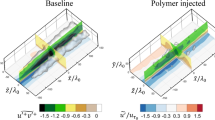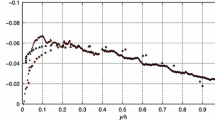Abstract
Manipulating the organized flow in the near-wall region of a turbulent boundary layer is a direct path to achieving skin-friction drag reduction. However, near-wall flow measurements in high Reynolds number (\(Re_{\tau }\)) wall flows can be challenging, due to this region’s small physical size and measurement resolution issues. The present study demonstrates the capability of hot-wire (HW) and stereoscopic particle image velocimetry (PIV) techniques of accurately estimating the trends of near-wall flow statistics in high-\(Re_{\tau }\) drag-reduced turbulent boundary layers. The drag reduction strategy considered involves imposition of streamwise travelling waves of spanwise wall oscillations, well known for attenuating the drag-producing near-wall streaks via unsteady cross-flow straining. A flow phase identification methodology is proposed, based on real-time tracking of the wall-oscillation cycle, to estimate the near-wall phase-based statistics from PIV experiments. This methodology is leveraged to investigate phase-specific orientations of the near-wall flow features, which have been shown in the literature to mimic the characteristics of the shear strain vector, dictating the efficacy of this drag reduction scheme. Reconciliation of the HW and PIV measurements demonstrates that the trends exhibited by higher-order moments of the near-wall streamwise velocity fluctuations, with increasing drag reduction, are representative of the inherent flow physics of the drag-reduced flow. Apart from assisting with the design of high-\(Re_{\tau }\) experiments over drag-reducing devices (riblets, plasma actuators, etc.), the present outcomes also inform high-\(Re_{\tau }\) studies in more general three-dimensional wall flows.










Similar content being viewed by others
Data Availibility
Data can be made available upon reasonable request.
References
Abdel-Rahman, A.A.: On the yaw-angle characteristics of hot-wire anemometers. Flow Meas. Instrum. 6(4), 271–278 (1995)
Abe, H.: Direct numerical simulation of a non-equilibrium three-dimensional turbulent boundary layer over a flat plate. J. Fluid Mech. 902, A20 (2020)
Agostini, L., Leschziner, M.: The impact of footprints of large-scale outer structures on the near-wall layer in the presence of drag-reducing spanwise wall motion. Flow Turbul. Combust. 100, 1037–1061 (2018)
Agostini, L., Leschziner, M.: The connection between the spectrum of turbulent scales and the skin-friction statistics in channel flow at \({R}e_{\tau }\)\(\approx\) 1000. J. Fluid Mech. 871, 22–51 (2019)
Agostini, L., Touber, E., Leschziner, M.: The turbulence vorticity as a window to the physics of friction-drag reduction by oscillatory wall motion. Int. J. Heat Fluid Flow 51, 3–15 (2015)
Akhavan, R., Jung, W., Mangiavacchi, N.: Control of wall turbulence by high frequency spanwise oscillations. AIAA Paper 93, 3282 (1993)
Astarita, T.: Analysis of weighting windows for image deformation methods in PIV. Exp. Fluids 43, 859–872 (2007)
Baron, A., Quadrio, M.: Turbulent drag reduction by spanwise wall oscillations. Appl. Sci. Res. 55, 311–326 (1995)
Bruun, H.: Hot-Wire Anemometry Princ. Signal Anal. Oxford University Press (1995)
Cameron, S.M., Nikora, V.I., Albayrak, I., Miler, O., Stewart, M., Siniscalchi, F.: Interactions between aquatic plants and turbulent flow: a field study using stereoscopic PIV. J. Fluid Mech. 732, 345–372 (2013)
Champagne, F.H., Sleicher, C.A., Wehrmann, O.H.: Turbulence measurements with inclined hot-wires part 1. heat transfer experiments with inclined hot-wire. J. Fluid Mech. 28(1), 153–175 (1967)
Chandran, D., Zampiron, A., Rouhi, A., Fu, M.K., Wine, D., Holloway, B., Smits, A.J., Marusic, I.: Turbulent drag reduction by spanwise wall forcing Part 2. high-Reynolds-number experiments. J. Fluid Mech. 968, 7 (2023)
Choi, H., Moin, P., Kim, J.: Direct numerical simulation of turbulent flow over riblets. J. Fluid Mech. 255, 503–539 (1993)
Choi, K., DeBisschop, J., Clayton, B.: Turbulent boundary-layer control by means of spanwise-wall oscillation. AIAA J. 36(7), 1157–1163 (1998)
Choi, K., Jukes, T., Whalley, R.: Turbulent boundary-layer control with plasma actuators. Phil. Trans. R Soc. A 369(1940), 1443–1458 (2011)
Corke, T.C., Thomas, F.O.: Active and passive turbulent boundary-layer drag reduction. AIAA J. 56(10), 3835–3847 (2018)
Deck, S., Renard, N., Laraufie, R., Weiss, P.: Large-scale contribution to mean wall shear stress in high-Reynolds-number flat-plate boundary layers up to 13650. J. Fluid Mech. 743, 202–248 (2014)
Deshpande, R., Chandran, D., Smits, A.J., Marusic, I.: On the relationship between manipulated inter-scale phase and energy-efficient turbulent drag reduction. J. Fluid Mech. 972, A12 (2023)
Devenport, W., Lowe, K.: Equilibrium and non-equilibrium turbulent boundary layers. Progr. Aerosp. Sci. 131(100), 807 (2022)
Dubief, Y., White, C., Terrapon, V., Shaqfeh, E., Moin, P., Lele, S.: On the coherent drag-reducing and turbulence-enhancing behaviour of polymers in wall flows. J. Fluid Mech. 514, 271–280 (2004)
Duong, A., Corke, T., Thomas, F.: Characteristics of drag-reduced turbulent boundary layers with pulsed-direct-current plasma actuation. J. Fluid Mech. 915, A113 (2021)
Duvvuri, S., McKeon, B.J.: Triadic scale interactions in a turbulent boundary layer. J. Fluid Mech. 767, R4 (2015)
Ferrante, A., Elghobashi, S.: On the physical mechanisms of drag reduction in a spatially developing turbulent boundary layer laden with microbubbles. J. Fluid Mech. 503, 345–355 (2004)
Gatti, D., Quadrio, M.: Reynolds-number dependence of turbulent skin-friction drag reduction induced by spanwise forcing. J. Fluid Mech. 802, 553–582 (2016)
Gatti, D., Stroh, A., Frohnapfel, B., Hasegawa, Y.: Predicting turbulent spectra in drag-reduced flows. Flow Turbul. Combus. 100(4), 1081–1099 (2018)
Gad-el Hak, M.: Flow Control Passiv. Act. React. Flow Manag. Cambridge University Press (2000)
Hamilton, J.M., Kim, J., Waleffe, F.: Regeneration mechanisms of near-wall turbulence structures. J. Fluid Mech. 287, 317–348 (1995)
Hutchins, N., Monty, J., Ganapathisubramani, B., Ng, H., Marusic, I.: Three-dimensional conditional structure of a high-Reynolds-number turbulent boundary layer. J. Fluid Mech. 673, 255–285 (2011)
Hwang, J., Sung, H.: Influence of large-scale motions on the frictional drag in a turbulent boundary layer. J. Fluid Mech. 829, 751–779 (2017)
Jiménez, J.: Coherent structures in wall-bounded turbulence. J. Fluid Mech. 842, P1 (2018)
Jiménez, J., Pinelli, A.: The autonomous cycle of near-wall turbulence. J. Fluid Mech. 389, 335–359 (1999)
Kim, J.: Physics and control of wall turbulence for drag reduction. Phil. Trans. R Soc. A 369(1940), 1396–1411 (2011)
Kim, J., Moin, P., Moser, R.: Turbulence statistics in fully developed channel flow at low Reynolds number. J. Fluid Mech. 177, 133–166 (1987)
Kline, S.J., Reynolds, W.C., Schraub, F., Runstadler, P.: The structure of turbulent boundary layers. J. Fluid Mech. 30(4), 741–773 (1967)
Lozano-Durán, A., Giometto, M., Park, G., Moin, P.: Non-equilibrium three-dimensional boundary layers at moderate Reynolds numbers. J. Fluid Mech. 883, A20 (2020)
di Mare, L., Jelly, T., Day, I.: Angular response of hot wire probes. Meas. Sci. Technol. 28(035), 303 (2017)
Marusic, I., Mathis, R., Hutchins, N.: Predictive model for wall-bounded turbulent flow. Science 329(5988), 193–196 (2010)
Marusic, I., Chauhan, K., Kulandaivelu, V., Hutchins, N.: Evolution of zero-pressure-gradient boundary layers from different tripping conditions. J. Fluid Mech. 783, 379–411 (2015)
Marusic, I., Chandran, D., Rouhi, A., Fu, M.K., Wine, D., Holloway, B., Chung, D., Smits, A.J.: An energy-efficient pathway to turbulent drag reduction. Nat. Commun. 12(1), 1–8 (2021)
Mathis, R., Marusic, I., Chernyshenko, S.I., Hutchins, N.: Estimating wall-shear-stress fluctuations given an outer region input. J. Fluid Mech. 715, 163–180 (2013)
Min, T., Kim, J.: Effects of hydrophobic surface on skin-friction drag. Phys. Fluids 16, 55–58 (2004)
Min, T., Yoo, J., Choi, H., Joseph, D.: Drag reduction by polymer additives in a turbulent channel flow. J. Fluid Mech. 486, 213–238 (2003)
Pal, S., Deutsch, S., Merkle, C.: A comparison of shear stress fluctuation statistics between microbubble modified and polymer modified turbulent boundary layers. Phys. Fluids A Fluid Dyn. 1(8), 1360–1362 (1989)
Perry, A.E.: Hot-wire anemometry. Oxford Science Publication (1982)
Quadrio, M., Ricco, P.: The laminar generalized Stokes layer and turbulent drag reduction. J. Fluid Mech. 667, 135–157 (2011)
Quadrio, M., Sibilla, S.: Numerical simulation of turbulent flow in a pipe oscillating around its axis. J. Fluid Mech. 424, 217–241 (2000)
Quadrio, M., Ricco, P., Viotti, C.: Streamwise-travelling waves of spanwise wall velocity for turbulent drag reduction. J. Fluid Mech. 627, 161–178 (2009)
Raffel, M., Willert, C., Scarano, F., Kähler, C., Wereley, S., Kompenhans, J.: Part. Image Velocim. A Pract. Guide. Springer (2018)
Ricco, P., Wu, S.: On the effects of lateral wall oscillations on a turbulent boundary layer. Exp. Thermal Fluid Sci. 29(1), 41–52 (2004)
Ricco, P., Skote, M., Leschziner, M.A.: A review of turbulent skin-friction drag reduction by near-wall transverse forcing. Prog. Aero Sci. 123(100), 713 (2021)
Rouhi, A., Fu, M.K., Chandran, D., Zampiron, A., Smits, A.J., Marusic, I.: Turbulent drag reduction by spanwise wall forcing. part 1. large-eddy simulations. J. Fluid Mech. 968, A6 (2023)
Schoppa, W., Hussain, F.: Coherent structure generation in near-wall turbulence. J. Fluid Mech. 453, 57–108 (2002)
Sillero, J.A., Jiménez, J., Moser, R.: Two-point statistics for turbulent boundary layers and channels at Reynolds numbers up to \({\delta }^{+}\)\(\approx\) 2000. Phys. Fluids 26(10), 105–109 (2014)
Smits, A., McKeon, B., Marusic, I.: High-Reynolds number wall turbulence. Ann. Rev. Fluid Mech. 43, 353–375 (2011)
Stokes, G.: On the effect of the internal friction of fluids on the motion of pendulums. Trans. Cambridge Philos. Soc. 9, 8–106 (1851)
Touber, E., Leschziner, M.: Near-wall streak modification by spanwise oscillatory wall motion and drag-reduction mechanisms. J. Fluid Mech. 693, 150–200 (2012)
Waleffe, F., Kim, J., Hamilton, J.M.: On the origin of streaks in turbulent shear flows. in Turbulent Shear Flows 8: Selected Papers from the Eighth International Symposium on Turbulent Shear Flows, Munich, Germany, pp. 37–49. Springer 1991 (1993)
Walsh, M.: Riblets as a viscous drag reduction technique. AIAA J. 21(4), 485–486 (1983)
Yao, J., Chen, X., Hussain, F.: Reynolds number effect on drag control via spanwise wall oscillation in turbulent channel flows. Phys. Fluids 31(8), 085–108 (2019)
Funding
This research was funded through the Deep Science Fund of Intellectual Ventures (IV) and the Discovery Project of the Australian Research Council (ARC). R. Deshpande also acknowledges financial support by the University of Melbourne through the Melbourne Postdoctoral Fellowship.
Author information
Authors and Affiliations
Contributions
R.D. led the preparation of the main manuscript with assistance from A.Z. and I.M.; D.C. and A.J.S. assisted with its reviewing and editing. I.M. and A.J.S. managed funding from ARC and IV and supervised the entire project.
Corresponding author
Ethics declarations
Conflict of interest
The authors declare that they have no conflict of interest.
Rights and permissions
Springer Nature or its licensor (e.g. a society or other partner) holds exclusive rights to this article under a publishing agreement with the author(s) or other rightsholder(s); author self-archiving of the accepted manuscript version of this article is solely governed by the terms of such publishing agreement and applicable law.
About this article
Cite this article
Deshpande, R., Zampiron, A., Chandran, D. et al. Near-Wall Flow Statistics in High-\(Re_{\tau }\) Drag-Reduced Turbulent Boundary Layers. Flow Turbulence Combust (2023). https://doi.org/10.1007/s10494-023-00510-6
Received:
Accepted:
Published:
DOI: https://doi.org/10.1007/s10494-023-00510-6




